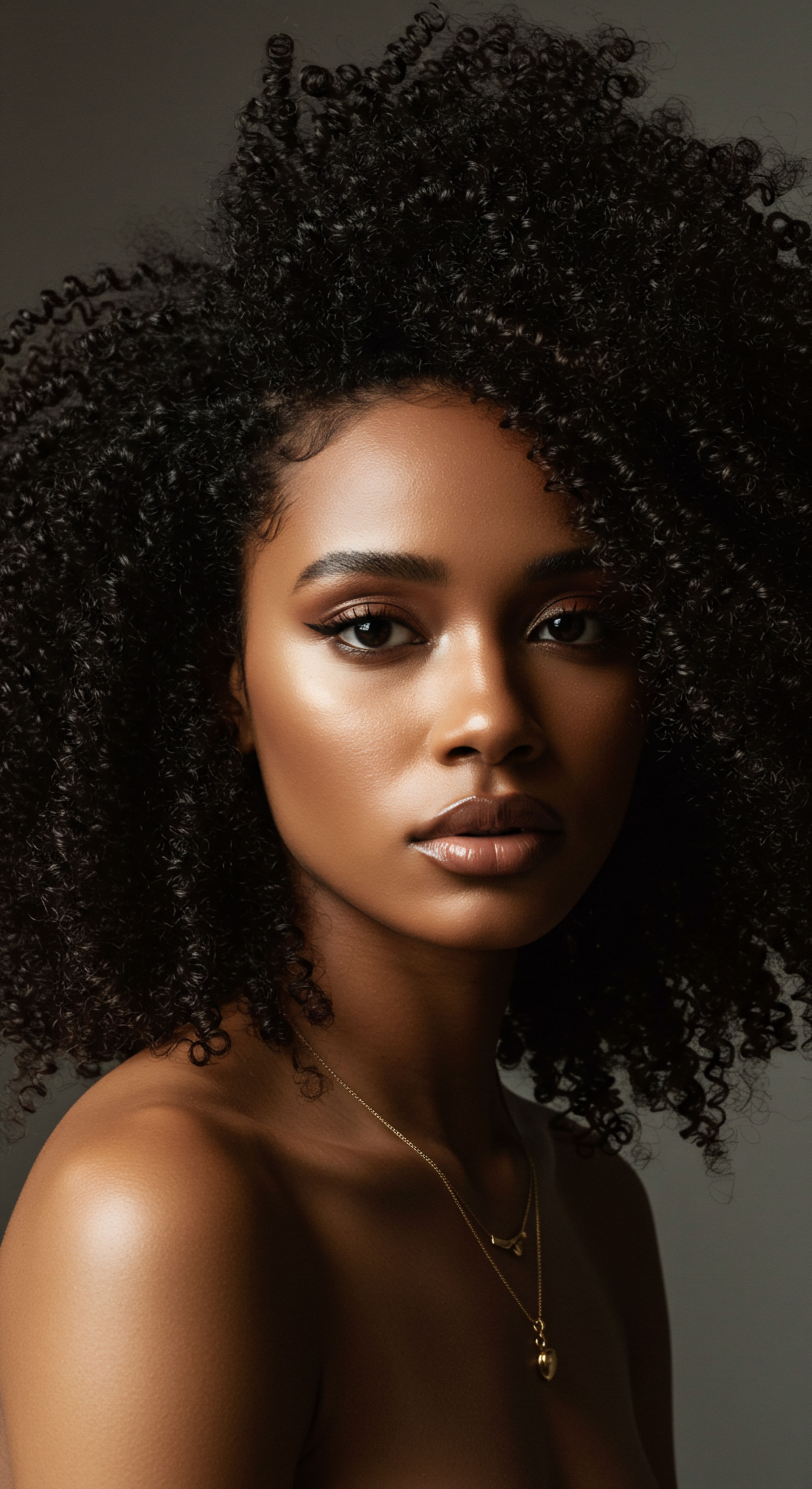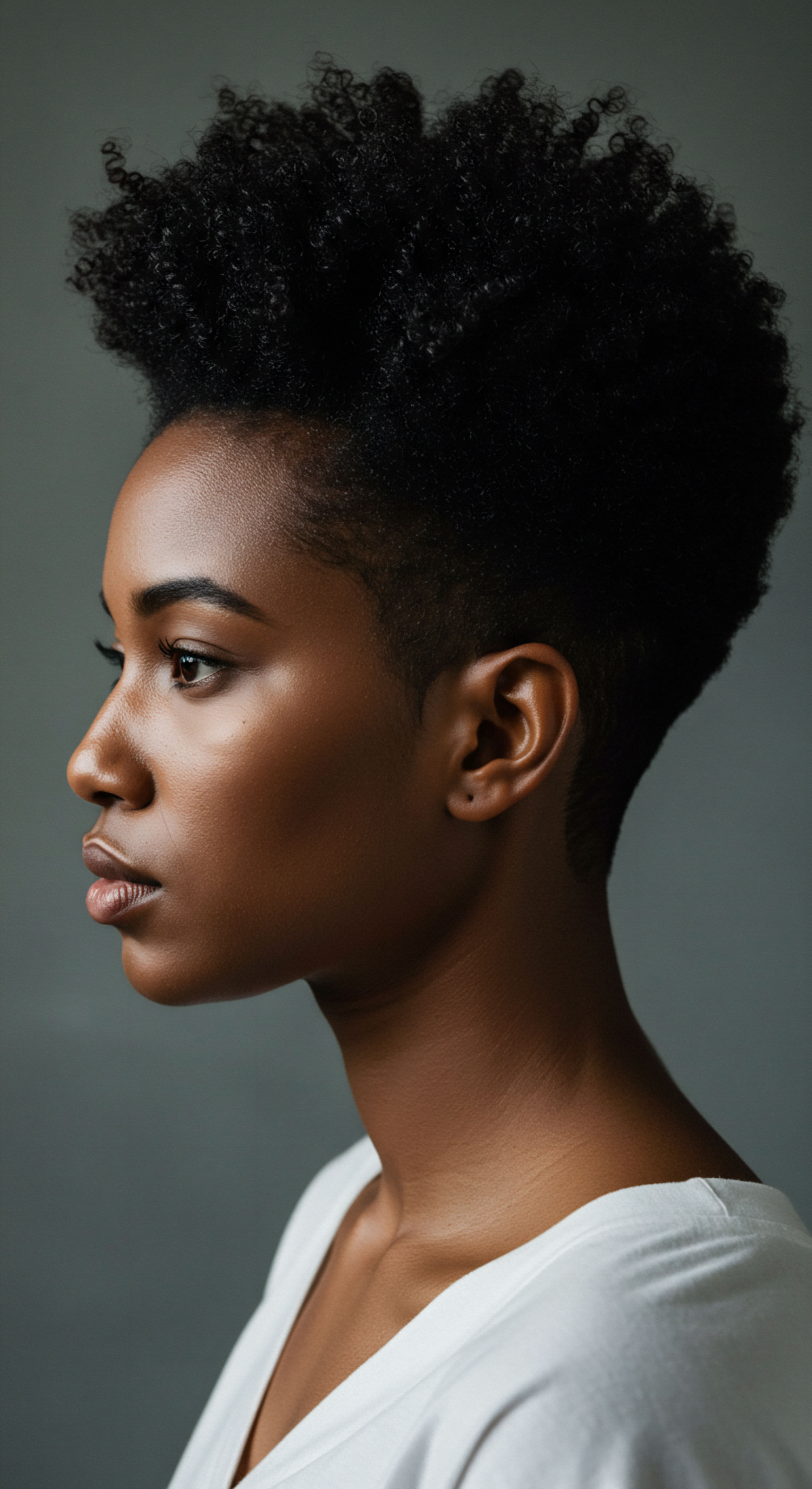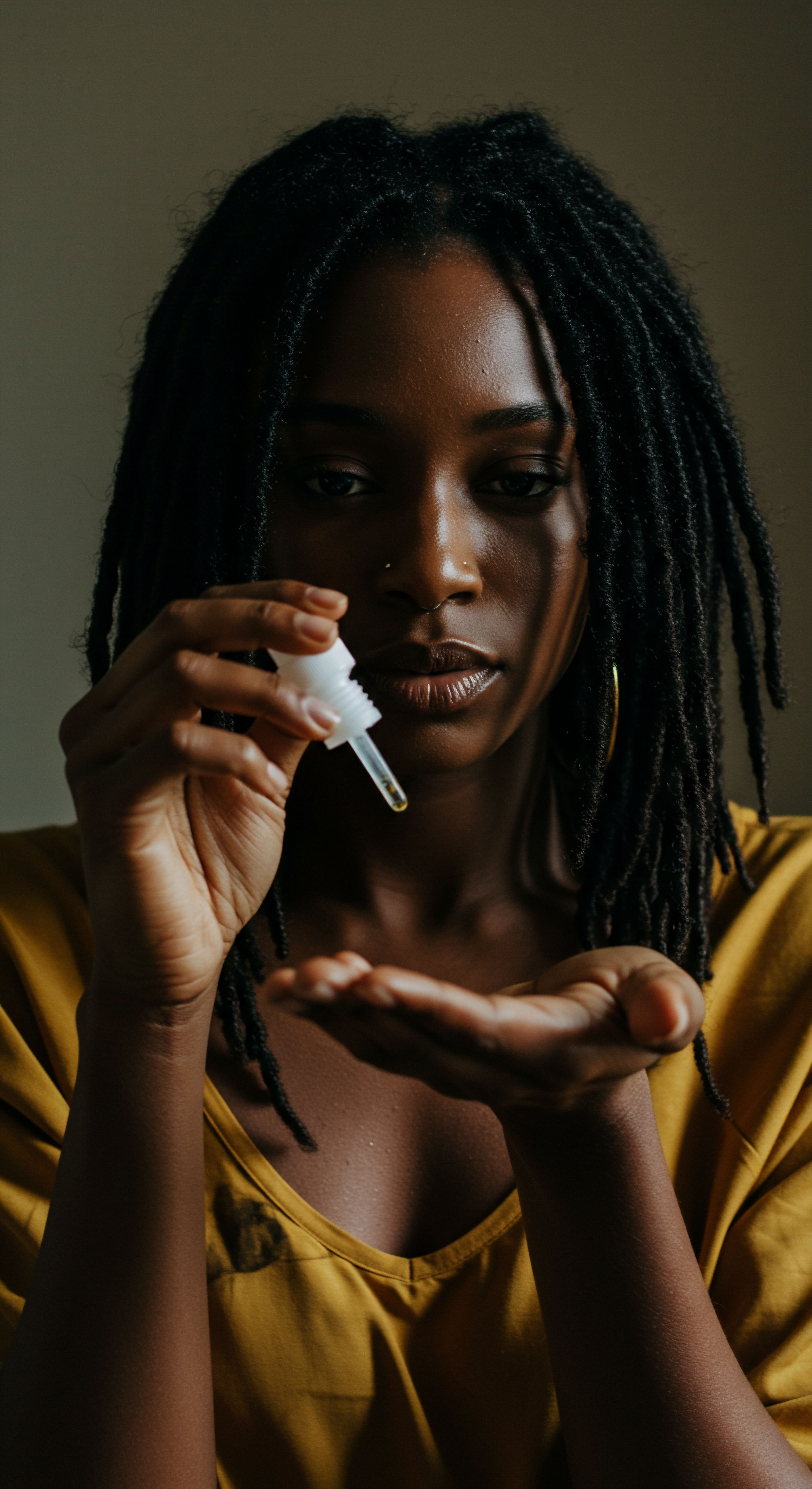
Roots
The quiet moments of rest, when the world outside softens its edges, hold a particular vulnerability for our hair. For those with textured strands, this nightly surrender to sleep is not merely a pause; it is a critical period that can either safeguard or compromise the vitality of their coils, curls, and waves. Understanding why this is so requires a gentle inquiry into the very nature of textured hair itself, alongside a recognition of ancient wisdom passed through generations.
Textured hair, with its inherent beauty and resilience, possesses a distinct anatomical blueprint. Unlike straight hair, which typically emerges from a round follicle, textured hair grows from an Elliptical Follicle, causing it to curl as it grows. This helical path creates natural points of curvature along each strand. At these bends, the hair’s outermost protective layer, the Cuticle, is naturally more exposed and prone to lifting.
Imagine a finely tiled roof; where the tiles curve, they are more susceptible to disturbance. This structural reality means textured hair is inherently more delicate, more susceptible to mechanical stress, and has a greater propensity for dryness.
For centuries, cultures with a deep connection to textured hair understood this intrinsic fragility. Long before modern science could peer into the microscopic world of hair cuticles, ancestral practices recognized the protective power of covering hair during periods of inactivity. Across various African communities, headwraps, known by names like ‘geles’ in Nigeria or ‘dukus’ in Ghana, served not only as markers of social status, marital standing, or spiritual observance but also as practical safeguards against the elements and the rigors of daily life, including sleep. These coverings, often crafted from smooth, natural fibers, provided a physical barrier, preserving styles and shielding strands from environmental aggressors.
The unique structure of textured hair, with its natural points of curvature, renders it inherently more delicate and susceptible to mechanical stress.
The tradition of wrapping hair for sleep is not merely a quaint custom; it is a testament to an intuitive understanding of hair biology. Enslaved African women in the United States, despite oppressive sumptuary laws that dictated their appearance, continued to wrap their hair, adapting these practices for protection and a quiet act of self-preservation. This continuity speaks volumes about the enduring wisdom embedded within these seemingly simple acts. The knowledge that a gentle covering could prevent tangles, reduce breakage, and maintain moisture was a practical truth, observed and transmitted across generations.
This historical context grounds our contemporary understanding. The gentle curves of textured hair, a hallmark of its beauty, are also the very reason it asks for a tender approach, especially during the hours of slumber. The foundational anatomy of the hair fiber sets the stage for why protective measures become not just beneficial, but essential for its long-term health and vitality.

Ritual
Moving from the inherent qualities of textured hair to the daily choices that sustain its health, we find ourselves contemplating the quiet ceremony of nighttime care. The transition from the day’s demands to the serenity of sleep offers a profound opportunity for hair renewal, a moment to shield delicate strands from the potential for damage that even gentle rest can bring. This section explores the deliberate practices and thoughtful choices that transform bedtime into a sanctuary for textured hair.
The selection of materials for sleep protection stands as a cornerstone of this nightly ritual. For generations, silk and satin have been the preferred fabrics for hair coverings and pillowcases, a preference rooted in their distinct physical properties. Unlike cotton, which possesses a porous surface that can absorb moisture and create friction, silk and satin offer a smooth, almost frictionless glide. This subtle difference is profoundly significant for textured hair, which, due to its unique curl pattern, is particularly prone to tangling and mechanical stress.
- Silk Pillowcases ❉ These provide a gentle surface for hair to rest upon, minimizing friction as one shifts during sleep. The smooth fibers allow hair to slide, reducing snagging and the mechanical abrasion that can lift cuticles and lead to frizz and breakage.
- Satin Bonnets ❉ A soft bonnet or scarf provides an encompassing shield, keeping all strands securely contained. This not only reduces contact with abrasive bedding but also helps to maintain the hair’s natural moisture balance, preventing it from drying out overnight.
- Loose Hairstyles ❉ Securing hair in a loose bun, a pineapple, or gentle braids before sleep can further reduce tangling and preserve curl definition. This method minimizes the surface area of hair exposed to friction and helps to keep the hair’s natural pattern intact.
The act of preparing hair for sleep becomes a mindful practice, a gentle offering to the strands that adorn us. It is a moment to slow down, to acknowledge the day’s environmental exposures, and to prepare the hair for a period of restorative peace. This thoughtful approach ensures that the hair, rather than suffering stress, can instead benefit from the quiet hours of the night.
Nighttime protection transforms sleep into a restorative period for textured hair, safeguarding its moisture and structural integrity.
Choosing the appropriate method depends on individual hair length, density, and curl pattern. A high pineapple, where hair is gathered loosely at the crown, works wonderfully for longer curls, keeping them elevated and away from the neck and pillow. Shorter styles might benefit more from a satin cap that completely encases the hair. Regardless of the chosen method, the underlying principle remains constant ❉ create a gentle, low-friction environment that allows hair to rest undisturbed.
| Method Silk/Satin Pillowcase |
| Primary Benefit for Textured Hair Reduces friction, retains moisture, minimizes frizz |
| Ideal Hair Length/Type All lengths and textures, especially loose curls |
| Method Satin Bonnet/Scarf |
| Primary Benefit for Textured Hair Encompasses hair, reduces friction, preserves moisture and style |
| Ideal Hair Length/Type All lengths and textures, particularly effective for defined styles |
| Method Pineapple Method |
| Primary Benefit for Textured Hair Preserves curl definition, reduces flattening |
| Ideal Hair Length/Type Longer curly or coily hair |
| Method Loose Braids/Twists |
| Primary Benefit for Textured Hair Minimizes tangling, maintains pattern, stretches curls gently |
| Ideal Hair Length/Type Medium to long hair, wavy to coily |
This daily ritual, steeped in both historical precedent and modern scientific understanding, allows for a conscious decision to protect and honor textured hair. It transforms a simple act of going to bed into a purposeful step toward vibrant, healthy strands.

Relay
To truly appreciate the deep significance of protecting textured hair during sleep, we must delve beyond surface observations, allowing science and cultural insight to intertwine. The mechanisms at play during our slumber are not merely anecdotal; they are rooted in the delicate biomechanics of the hair fiber and the unique needs of its structure. This exploration seeks to bridge the gap between traditional wisdom and contemporary scientific understanding, revealing the profound impact of nighttime care.

What Happens to Textured Hair During Unprotected Sleep?
Unprotected sleep subjects textured hair to a relentless cycle of mechanical stress and moisture depletion. As one shifts and turns throughout the night—an average person moves up to 40 times—the hair rubs against pillowcase fabrics. Cotton, a widely used bedding material, possesses a rough, absorbent surface at a microscopic level. This roughness creates Friction, a force that acts against the smooth movement of hair strands.
This friction has a detrimental effect on the hair’s cuticle, the outermost layer composed of overlapping scales. Imagine these scales as shingles on a roof. When subjected to constant rubbing, these scales lift, chip, and can even break away.
A compromised cuticle leaves the hair’s inner cortex vulnerable, leading to increased porosity, dryness, and a dull appearance. This phenomenon contributes significantly to frizz, tangling, and ultimately, breakage.
Beyond mechanical damage, traditional pillowcases contribute to Moisture Loss. Cotton is a highly absorbent fiber, readily drawing moisture from anything it touches, including hair. Textured hair, by its very nature, tends to be drier than straighter hair types because the natural oils produced by the scalp struggle to travel down the curves and coils of the hair shaft.
When already prone to dryness, the absorption of precious moisture by a cotton pillowcase exacerbates this vulnerability, leaving strands brittle, rough, and more susceptible to damage. This can lead to a phenomenon known as hygral fatigue, where repeated swelling and drying of the hair fiber compromises its integrity.
The delicate balance of textured hair’s moisture and structural integrity faces constant challenge from friction and absorption during unprotected sleep.
Consider a compelling study published in the Journal of Cosmetic Dermatology, which quantified the reduction in hair friction. It demonstrated that a smooth surface, such as silk, can reduce hair friction by up to 43% compared to other materials. This significant reduction directly translates to less cuticle damage, fewer tangles, and a noticeable decrease in breakage for those with delicate hair types. This quantitative evidence supports the long-held intuition that gentle surfaces are paramount for hair health.

How Does Protective Sleepwear Address These Challenges?
The use of silk or satin sleepwear, whether in the form of pillowcases, bonnets, or scarves, offers a scientifically sound solution to the nightly aggressors.
- Reduced Friction ❉ The smooth, tightly woven fibers of silk and satin present a significantly lower coefficient of friction compared to cotton. This allows hair to glide effortlessly across the surface, preventing the snagging and tugging that lead to cuticle damage, frizz, and tangles. This gentle interaction preserves the hair’s structural integrity, maintaining its natural smoothness and shine.
- Moisture Retention ❉ Unlike cotton, silk is a protein-based fiber that is far less absorbent. It does not wick away the hair’s natural oils or applied moisturizing products. This property helps textured hair retain its essential hydration throughout the night, preventing dryness, brittleness, and subsequent breakage. By keeping the hair adequately moisturized, its elasticity is better preserved, making it more resilient.
- Style Preservation ❉ Beyond the direct benefits to hair health, protective sleepwear also serves a practical purpose in maintaining hairstyles. By keeping curls, braids, or twists contained and undisturbed, it reduces the need for excessive manipulation and restyling in the morning. Less manipulation means less mechanical stress, contributing to the overall health and longevity of the hair.
The cultural continuity of protecting hair during sleep speaks to an ancient, observational science. What was once understood through generations of lived experience and practical results is now affirmed by modern trichology and material science. The deliberate choice to protect textured hair at night is a powerful act of care, grounded in both historical reverence and verifiable scientific principles, ensuring that each morning greets strands with renewed strength and softness.

Reflection
As the day draws to a close and the quiet hush of evening settles, the simple act of preparing one’s hair for sleep becomes more than a routine; it transforms into a gentle conversation with oneself, a whisper of self-care passed through time. The journey of understanding why we protect textured hair at night, from its deep roots in ancestral wisdom to the illuminating insights of modern science, reveals a profound connection between heritage and health. It is a testament to the enduring human desire to nurture what is precious, to honor the beauty that resides within our very being. Each silk bonnet donned, each satin pillow embraced, carries the quiet weight of generations who understood the delicate dance of hair and rest, a practice that continues to affirm the strength and beauty of textured strands in a world ever learning to appreciate their unique rhythm.

References
- Byrd, Ayana, and Lori L. Tharps. Hair Story ❉ Untangling the Roots of Black Hair in America. St. Martin’s Griffin, 2014.
- Davis-Sivasothy, Audrey. The Science of Black Hair ❉ A Comprehensive Guide to Textured Care. Saga Publishing, 2011.
- Dabiri, Emma. Twisted ❉ The Tangled History of Black Hair Culture. Harper Perennial, 2020.
- Schwartz, A. M. & Knowles, D. C. Frictional Effects in Human Hair. Journal of the Society of Cosmetic Chemists, 1963.
- Bhushan, B. et al. Friction Dynamics of Straight, Curly, and Wavy Hair. Journal of the Mechanical Behavior of Biomedical Materials, 2014.
- Wong, Nikita, et al. Historical Perspectives on Hair Care and Common Styling Practices in Black Women. MDedge, 2025.
- Martel, J.L. Miao, J.H. & Badri, T. Anatomy, Hair Follicle. StatPearls, 2024.
- Robbins, Clarence R. Chemical and Physical Behavior of Human Hair. Springer, 2012.
- Synnott, Anthony. Shame and Glory ❉ A Sociology of Hair. The British Journal of Sociology, 1987.
- Ghosh, S. et al. The Genomic Variation in Textured Hair ❉ Implications in Developing a Holistic Hair Care Routine. MDPI, 2024.
- Messenger, A. G. & de la Garza, A. Hair and Scalp Diseases ❉ The Textbook of Cosmetic Dermatology. CRC Press, 2010.
- Bouhanna, P. & de la Garza, A. Hair and Scalp Diseases ❉ The Textbook of Cosmetic Dermatology. CRC Press, 2010.